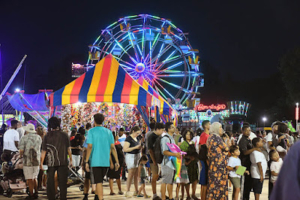
Arlington County Fair At Thomas Jefferson Community Center/Middle School
For more than two centuries, Columbia Pike has been home to communities that reflect Arlington’s changing character. What began as scattered farms and toll houses has become one of the most diverse corridors in the Washington region. Today, more than 130 languages are spoken along the Pike. This is a living testament to the waves of people who have made Arlington their home. The Columbia Pike Partnership often describes the corridor as “the world in a zip code,” a phrase that captures both its density and cultural richness.
Early Communities and Freedman’s Village
In the 19th century, families such as the Hunters, Munsons, Corbetts, and Youngs farmed the land along Columbia Pike. Churches like Trinity and Hunter’s Chapel served as gathering places, anchoring early neighborhoods, as noted in the Arlington Historical Magazine (1989). With the outbreak of the Civil War, the rural landscape changed dramatically. The federal government established Freedman’s Village on land near the Pike in 1863, providing housing, schools, and work opportunities for formerly enslaved people. As Collins and Stewart recount in their 1989 history, although the village closed by the 1890s, many residents resettled in nearby communities such as Nauck (now Green Valley), Arlington View, Queen City, and Butler-Holmes. These African American neighborhoods became central to Arlington’s civic life for generations.
Growth and Community Anchors
As Arlington grew in the early 20th century, Columbia Pike became more than a transportation corridor. It became a place where neighborhoods took root. Communities like Alcova Heights and Barcroft attracted families seeking affordable homes. At the same time, churches such as Arlington United Methodist and St. John’s Baptist continued to serve as neighborhood anchors, carrying forward congregations that traced their roots to the 19th century.
By the 1930s and 40s, shopping centers such as Arlington Village and Westmont reflected national trends in “one-stop” retail. Arlington County’s official development history notes that these centers introduced a new model of community gathering, complementing the Pike’s residential growth and reinforcing its role as a hub for daily life.
Cultural Mosaic of Today
By the late 20th century, Columbia Pike had become one of the most ethnically diverse places in the Washington region. Immigrant families from Latin America, Asia, the Middle East, and Africa joined long-established African American and white working-class communities, creating a vibrant cultural mix. Today, restaurants serve dishes from across the globe, shops carry international goods, and local festivals celebrate traditions from dozens of cultures.
This living diversity is vividly documented in the Columbia Pike Documentary Project (CPDP), launched in 2007 by photographer Lloyd Wolf and collaborators. Through portraits of shopkeepers, families, and community events, the project provides a contemporary record of resilience and adaptation, echoing the Pike’s long history of cultural convergence.
Continuity and Change
Even as redevelopment brings new apartments and businesses, revitalization efforts such as the Columbia Pike Initiative (1998) and the Form-Based Code (2003) have sought to balance growth with affordability and cultural preservation. Arlington County planning records emphasize that these measures were designed to sustain the Pike’s diversity while guiding redevelopment.
Columbia Pike’s story is ultimately one of people. From the residents of Freedman’s Village to today’s multilingual communities, each generation has left its mark while holding onto a sense of belonging. The Pike remains Arlington’s “Main Street,” a place where history, culture, and community converge.


